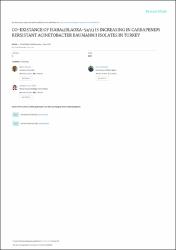Co-existance of ISABA1/BLA(OXA-51/23) is increasing in carbapenem rersistant acinetobacter baumannii isolates in Turkey
Citation
Uzunoğlu, E., Direkel, Ş., Koçbıyık, M., Uludağ, S. & Çiçek, A.Ç. (2017). Co-existance of ISABA1/BLA(OXA-51/23) is increasing in carbapenem rersistant acinetobacter baumannii isolates in Turkey. Acta Medica Mediterranea, 33(6), 1001-+. https://doi.org/10.19193/0393-6384_2017_6_159Abstract
Introduction: Carbapenem resistant Acinetobacter baumannii (A. baumannii) strains are challenging topics for hospitals. We determined the antibiotic susceptibilities and genetic resistance mechanisms of 135 A. baumannii isolates from Giresun State Hospital, Turkey between January 2013 and September 2014. Material and methods: Antimicrobial susceptibility tests were performed according to the Clinical and Laboratory Standarts Institute guidelines. beta-lactamase coding genes were investigated by simplex/multiplex PCR. Results: High rates of multi drug resistance (51.11%) and extensively drug-resistance (48.14%) were remarkable. Colistin was seemed to be the only active compound against all clinical strains. Isolates were found 100% positive for bla(OXA-51) and 95.55% positive for bla(OXA-23). of all the isolates, 97.05% were found to be blaTEM (n=131) positive concomitant with whether bla(OXA-51) or bla(OXA23) or both them. All strains were negative for the rest of the beta-lactamase coding genes. ISAb1 element was positive in the 98.51% (n=133) of the isolates and 100% of them were located upstream of bla(OXA-51/23). Conclusion: To our knowledge this study revealed the highest co-existence of bla(OXA-51/23) and also demonstrated the increase of co-existence of both bla(OXA-51/23) and ISAba1/bla(OXA-51/23) over time in Turkey. the increasing combination of these genes and element may lead more resistance against to carbapenems among A. baumannii isolates.


















